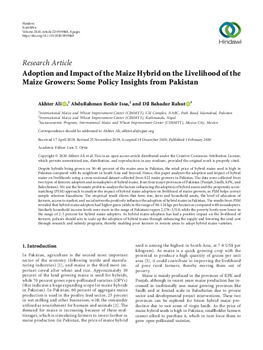Adoption and impact of the maize hybrid on the livelihood of the maize growers: some policy insights from Pakistan
Abstract
Despite hybrids being grown on 30–40 percent of the maize area in Pakistan, the retail price of hybrid maize seed is high in Pakistan compared with its neighbors in South Asia and beyond. Hence, this paper analyzes the adoption and impact of hybrid maize on livelihoods using a cross-sectional dataset collected from 822 maize growers in Pakistan. The data were collected from two types of farmers: adopters and nonadopters of hybrid maize, from four major provinces of Pakistan (Punjab, Sindh, KPK, and Balochistan). We use the bivariate probit to analyze the factors influencing the adoption of hybrid maize and the propensity score-matching (PSM) approach to analyze the impact of hybrid maize adoption on livelihood of maize growers, as PSM helps correct sample selection biasedness. The empirical result shows that farm size, farm and household assets, the level of education of farmers, access to market, and social networks positively influence the adoption of hybrid maize in Pakistan. The results from PSM revealed that hybrid maize adopters had higher grain yields in the range of 94–124 kgs per hectare as compared with nonadopters. Similarly household income levels were more in the range of Pakistani rupees 2,176–3,518, while the poverty levels were lower in the range of 2-3 percent for hybrid maize adopters. As hybrid maize adoption has had a positive impact on the livelihood of farmers, policies should aim to scale up the adoption of hybrid maize through enhancing the supply and lowering the seed cost through research and subsidy programs, thereby enabling poor farmers in remote areas to adopt hybrid maize varieties

